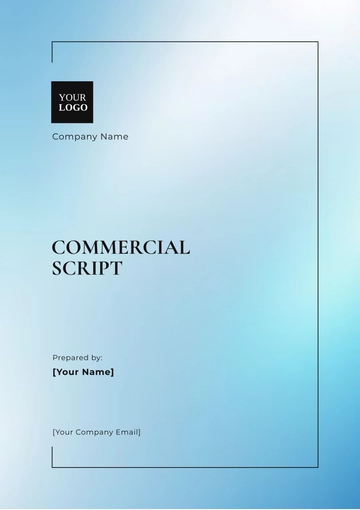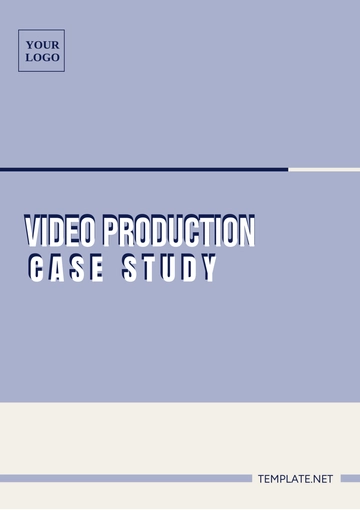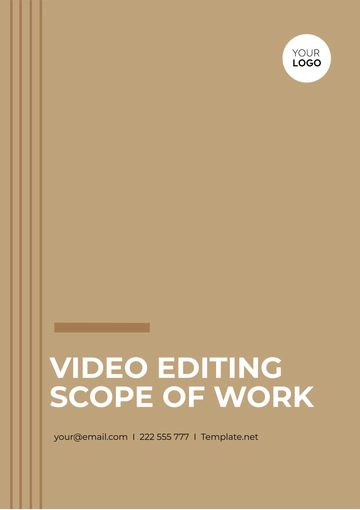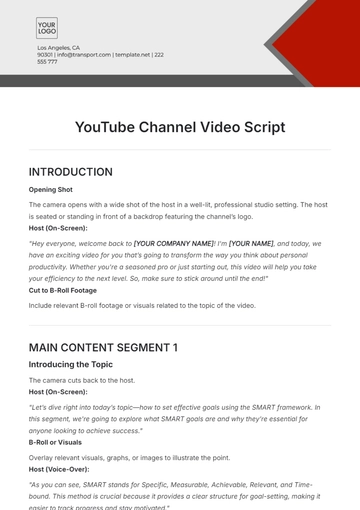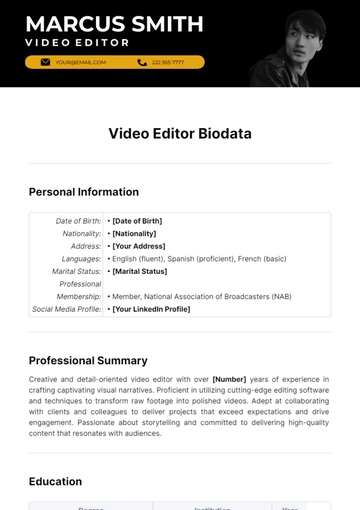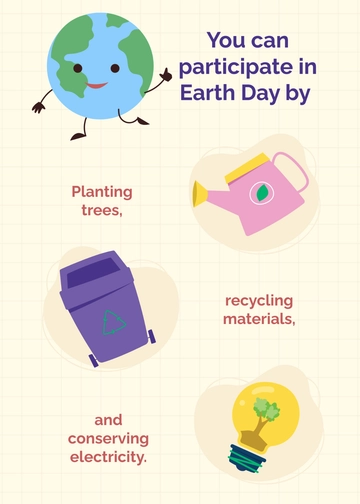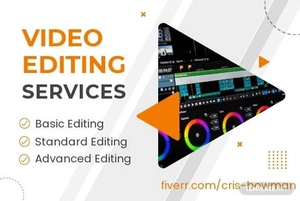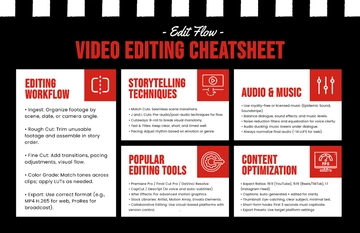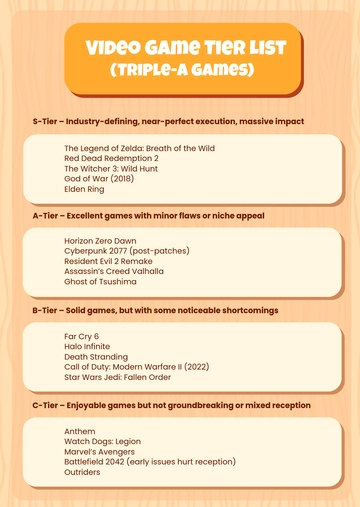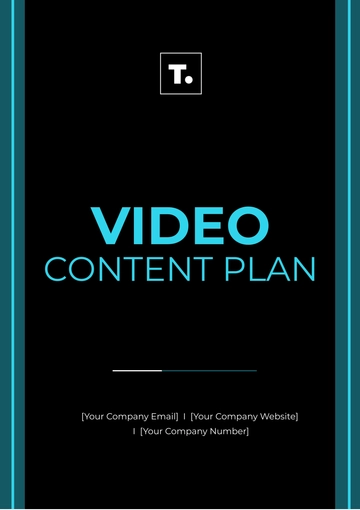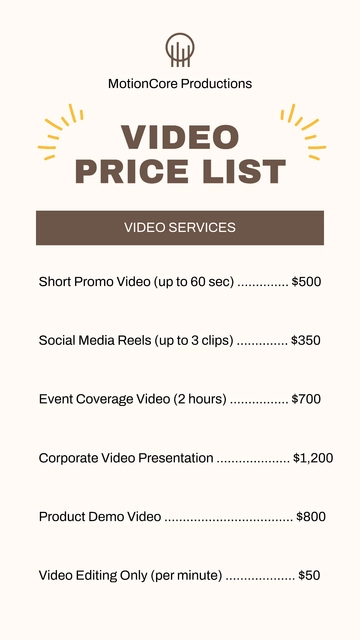Free Video Brief
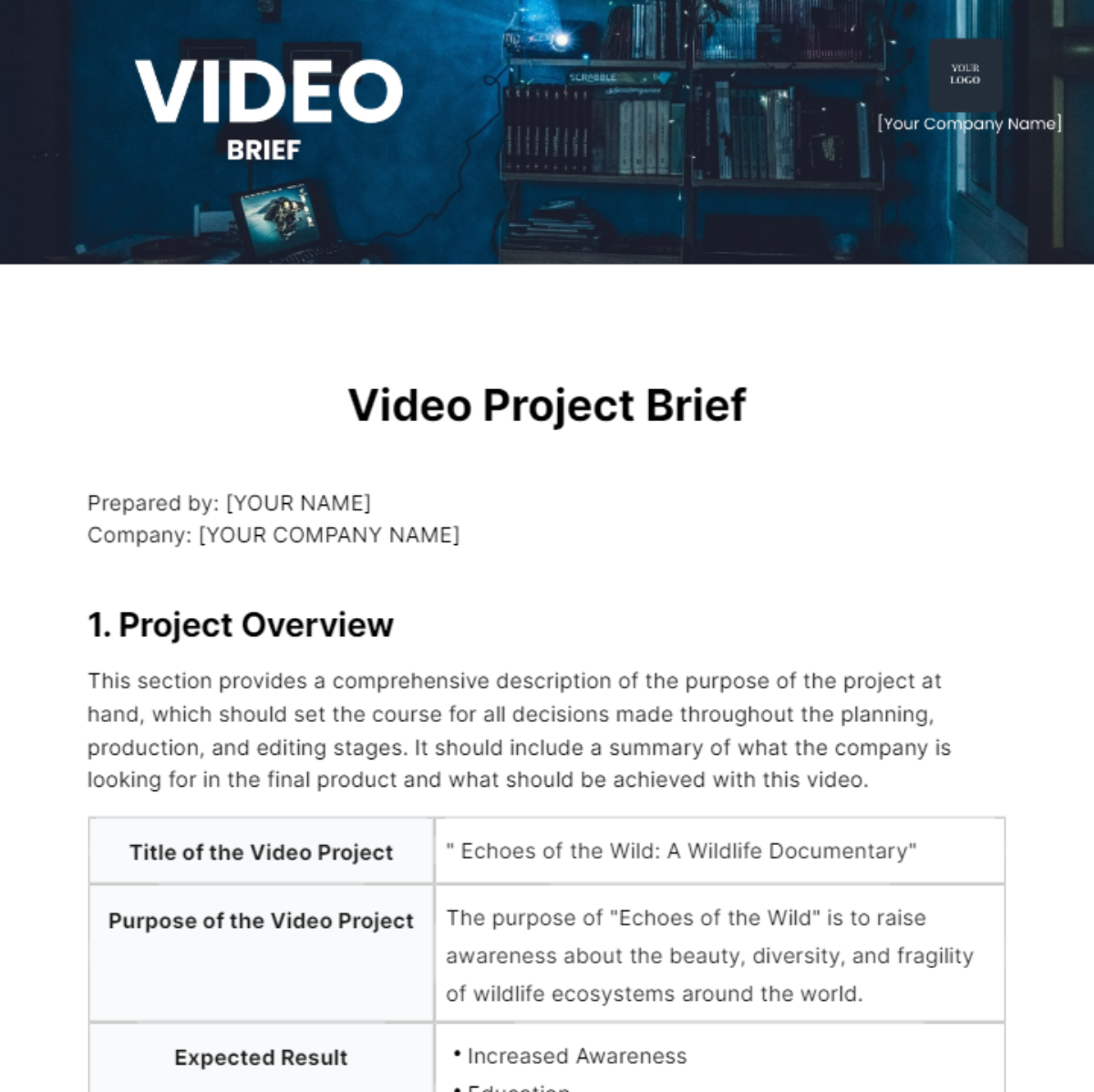
Prepared by: [YOUR NAME]
Company: [YOUR COMPANY NAME]
1. Project Overview
This section provides a comprehensive description of the purpose of the project at hand, which should set the course for all decisions made throughout the planning, production, and editing stages. It should include a summary of what the company is looking for in the final product and what should be achieved with this video.
Title of the Video Project | " Echoes of the Wild: A Wildlife Documentary" |
|---|---|
Purpose of the Video Project | The purpose of "Echoes of the Wild" is to raise awareness about the beauty, diversity, and fragility of wildlife ecosystems around the world. |
Expected Result |
|
2. Target Audience
The video should be tailored to suit your target audience's needs and preferences. In this section, significant details about the target audience will be covered. This will ensure that the video content, style, and message are relevant and engaging to them.
Demographics:
Nature Enthusiasts
Environmentalists
Students and Educators
Families
Travelers and Adventure Seekers
Conservationists and Wildlife Researchers
Interests:
Nature and Wildlife
Conservation and Environmentalism
Travel and Adventure
Photography and Filmmaking
Education and Learning
Outdoor Activities
Documentary Films
Consumer Behavior:
Motivation
Perception
Attitudes
Information Processing
Emotions
Social Influences
Behavioral Intentions
3. Style and Tone
The envisioning of the video's look, feel, pacing, and tonality is laid out in this section. The style must be consistent with your brand and appealing to your target audience. It may also include any specific stylistic preferences such as the use of branding elements, color scheme, etc.
General Look:
Cinematic Quality
Rich Color Palette
Natural Lighting
Immersive Sound Design
Dynamic Camera Movement
Intimate Encounters
Narrative Structure
Mood and Tone
Mood
Tone:
Emotional Resonance
Balance
Narrative Flow
Branding Elements to Include:
Logo Animation
Typography
Color Palette
Watermark
Transition Effects
Sound Design
End Credits
Promotional Materials
4. Technical Requirements
This section defines the technical aspects needed for the project. It entails details regarding the period, platform, format, and quality of the video. It also defines other utilities to be incorporated during production and post-production.
Comprehensive List | Description |
|---|---|
Camera Equipment | High-quality cameras capable of capturing stunning visuals in various environments, including DSLRs, mirrorless cameras, or professional cinema cameras. |
Audio Equipment | Professional microphones, including shotgun microphones, lavalier microphones, and field recorders, capture clear and immersive soundscapes in diverse recording conditions. |
Lighting Equipment | Lighting kits or portable LED panels to enhance visibility and aesthetics during indoor interviews or controlled filming environments. |
Stabilization Equipment | Gimbal stabilizers, tripods, or camera rigs to ensure steady and smooth footage, especially during handheld or moving shots. |
Editing Software | Professional video editing software such as Adobe Premiere Pro, Final Cut Pro, or DaVinci Resolve for editing, color grading, and post-production effects. |
Storage Solutions | Sufficient storage space, including external hard drives or cloud storage, to store raw footage, project files, and backups securely. |
Copyright and Licensing | Compliance with copyright laws and licensing agreements for all media assets used in the video project, including music, stock footage, and graphics. |
5. Budget
These tables provide a breakdown of estimated costs for each phase of the project, allowing for better budget planning and management. Adjustments can be made based on specific project requirements, available resources, and financial considerations.
Pre-Production:
Budget Category | Estimated Cost Range |
|---|---|
Concept Development and Research | $1,000 - $5,000 |
Scriptwriting | $500 - $2,000 |
Location Scouting | $500 - $2,000 |
Crew Recruitment | $5,000 - $20,000 |
Equipment Acquisition | $5,000 - $20,000 |
Permits and Insurance | $1,000 - $5,000 |
Production:
Budget Category | Estimated Cost Range |
|---|---|
Travel and Accommodation | $5,000 - $30,000 |
Equipment Maintenance | $1,000 - $5,000 |
Catering and Craft Services | $1,000 - $5,000 |
Miscellaneous Expenses | $1,000 - $5,000 |
Post-Production:
Budget Category | Estimated Cost Range |
|---|---|
Editing and Post-Production | $5,000 - $20,000 |
Music Licensing | $1,000 - $5,000 |
Graphics and Visual Effects | $1,000 - $5,000 |
Review and Feedback | $500 - $2,000 |
Distribution and Promotion:
Budget Category | Estimated Cost Range |
|---|---|
Film Festival Submissions | $500 - $5,000 |
Marketing and Promotion | $5,000 - $20,000 |
Distribution Fees | $1,000 - $10,000 |
Outreach and Engagement | $1,000 - $5,000 |
Contingency:
Budget Category | Estimated Cost Range |
|---|---|
Contingency Fund | 10% - 20% of total budget |
6. Project Timeline
Creating a project timeline for "Echoes of the Wild: A Wildlife Documentary" involves breaking down the production process into manageable tasks and setting deadlines for each stage. Here's a general timeline outline:
Pre-Production Phase (3-6 months before filming):
Concept Development: Define the theme, narrative structure, and key messaging of the documentary.
Research and Scriptwriting: Conduct research on wildlife species, habitats, and conservation issues. Develop a script outlining the storyline, scenes, and interview questions.
Location Scouting: Identify and scout filming locations, considering factors such as accessibility, permits, and wildlife sightings.
Crew Recruitment: Hire a production team, including directors, cinematographers, sound technicians, and editors.
Equipment Acquisition: Purchase or rent a necessary camera, audio, lighting, and stabilization equipment.
Budget Planning: Create a budget detailing expenses for equipment, travel, accommodations, permits, and post-production.
Production Phase (1-3 months of filming):
Filming Schedule: Develop a detailed shooting schedule, taking into account travel logistics, weather conditions, and seasonal wildlife migrations.
On-location Filming: Capture footage and conduct interviews according to the shooting schedule, following safety protocols and ethical guidelines for wildlife interaction.
Backup Plans: Have contingency plans in place for unexpected challenges, such as inclement weather or equipment malfunctions.
Daily Log and Asset Management: Maintain a log of footage, audio recordings, and production notes to track progress and ensure organizational efficiency.
Post-Production Phase (2-4 months after filming):
Footage Review and Selection: Review and select the best footage and audio recordings for use in the documentary.
Editing and Storytelling: Edit the footage together to create a cohesive narrative, incorporating visual effects, music, and sound design as needed.
Color Grading and Audio Mixing: Enhance the visual and auditory elements of the documentary through color grading, audio mixing, and sound editing techniques.
Review and Feedback: Share rough cuts of the documentary with stakeholders for feedback and revisions.
Finalizing and Exporting: Make final adjustments and export the completed documentary in the appropriate formats for distribution.
Distribution and Promotion (ongoing):
Distribution Strategy: Plan for distribution across various platforms, including film festivals, streaming services, broadcast television, and online channels.
Marketing and Promotion: Develop a marketing strategy to promote the documentary through trailers, social media campaigns, press releases, and screenings.
Outreach and Engagement: Engage with target audiences, conservation organizations, and media outlets to raise awareness and generate interest in the documentary.
Evaluation and Impact Assessment: Monitor audience feedback, viewership metrics, and media coverage to assess the impact of the documentary and identify opportunities for future projects.
It's important to note that the timeline may vary depending on factors such as project scope, budget constraints, and availability of resources. Flexibility and adaptability are key to successfully navigating the production process and delivering a compelling wildlife documentary.
- 100% Customizable, free editor
- Access 1 Million+ Templates, photo’s & graphics
- Download or share as a template
- Click and replace photos, graphics, text, backgrounds
- Resize, crop, AI write & more
- Access advanced editor
Introducing the Video Brief Template from Template.net – your ultimate tool for streamlined project planning. Crafted with precision, this editable and customizable template ensures seamless communication between teams. Effortlessly outline project objectives, deadlines, and creative concepts. Plus, it's editable in our AI Editor too, empowering you to refine your vision with ease. Streamline your workflow today!
